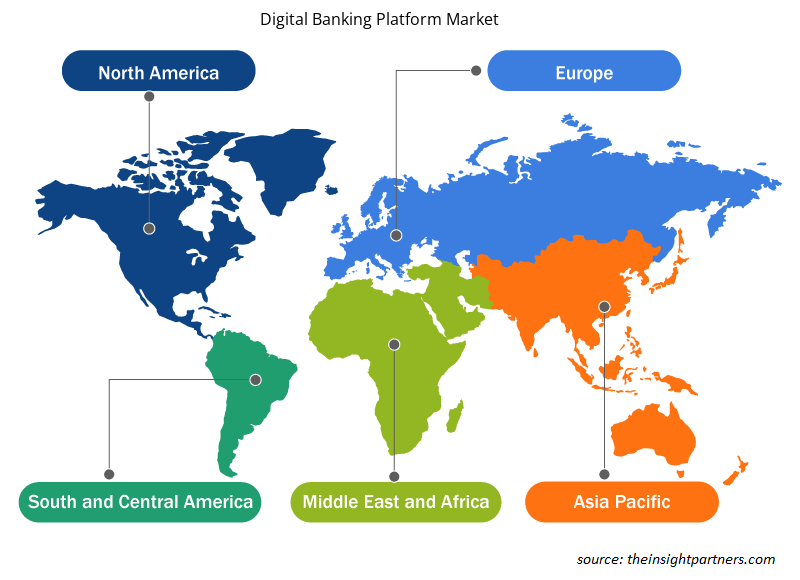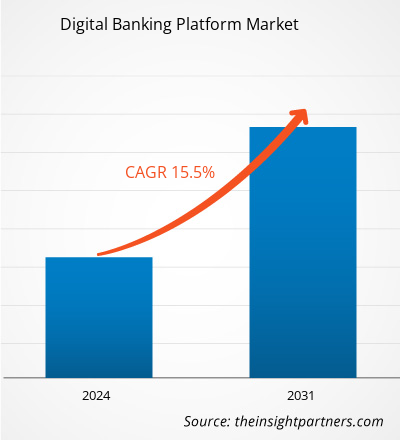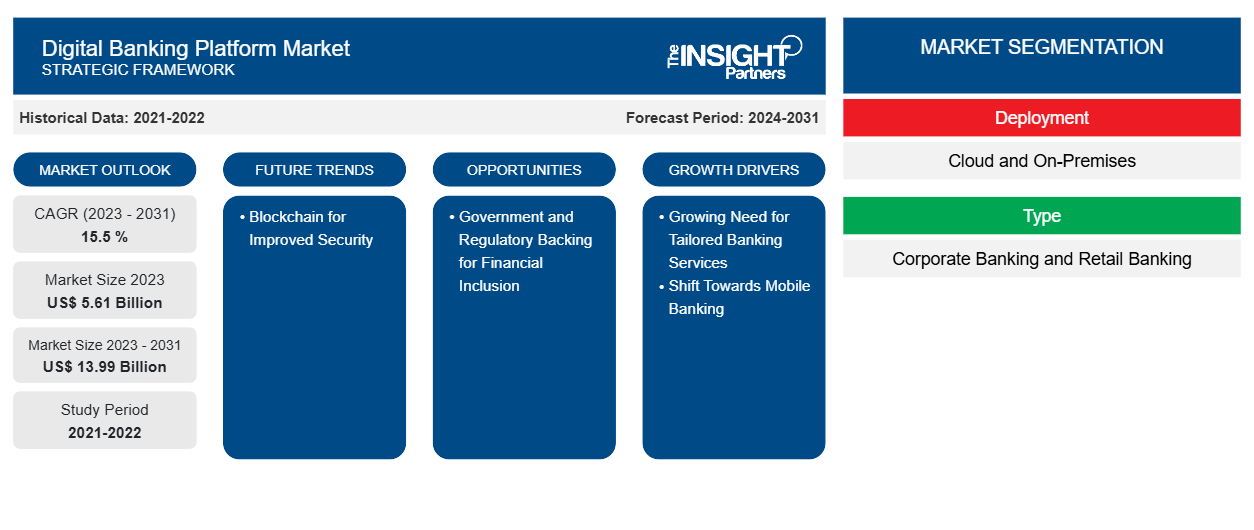Si prevede che la dimensione del mercato delle piattaforme di digital banking raggiungerà i 13,99 miliardi di dollari entro il 2031, rispetto ai 5,61 miliardi di dollari del 2023. Si prevede che il mercato registrerà un CAGR del 15,5% nel 2023-2031. La crescente necessità di servizi bancari personalizzati e di supporto normativo per l'inclusione finanziaria rimarrà probabilmente una delle principali tendenze del mercato delle piattaforme di digital banking.
Analisi di mercato della piattaforma bancaria digitale
Con l'aumento dell'uso dei telefoni cellulari, sempre più persone scelgono di utilizzare il mobile banking per la sua praticità. Questo cambiamento ha incoraggiato le banche a creare sistemi di digital banking che possono essere utilizzati su dispositivi mobili, consentendo agli utenti di effettuare le proprie operazioni bancarie in movimento. Inoltre, questi sistemi aiutano le banche a rendere le proprie operazioni più efficienti, a tagliare le spese e a integrare tecnologie moderne come l'intelligenza artificiale e l'analisi dei dati per personalizzare i servizi e migliorare il processo decisionale.
Panoramica del mercato delle piattaforme di digital banking
Una piattaforma di digital banking è un sistema elettronico disponibile tramite Internet o app mobili, che consente ai consumatori di svolgere da remoto varie attività bancarie e transazioni finanziarie. Queste attività includono la gestione dei conti, i pagamenti, le richieste di prestito e l'accesso a un'ampia gamma di servizi bancari. La piattaforma offre anche funzionalità come la gestione dei conti, i depositi mobili, i portafogli digitali, gli strumenti di budget e l'assistenza clienti tramite chatbot o servizi di messaggistica. I principali vantaggi delle piattaforme di digital banking sono la praticità, l'accessibilità e l'efficienza sia per i clienti che per le banche. Gli utenti possono effettuare comodamente transazioni bancarie senza recarsi in una filiale fisica, il che porta a una maggiore soddisfazione e coinvolgimento dei clienti.
Personalizza questo report in base alle tue esigenze
Riceverai la personalizzazione gratuita di qualsiasi report, comprese parti di questo report, o analisi a livello nazionale, pacchetto dati Excel, oltre a usufruire di grandi offerte e sconti per start-up e università
-
Scopri le principali tendenze di mercato in questo rapporto.Questo campione GRATUITO includerà analisi di dati che spaziano dalle tendenze di mercato alle stime e alle previsioni.
Driver e opportunità del mercato delle piattaforme di digital banking
Crescente necessità di servizi bancari personalizzati per favorire il mercato
C'è una tendenza crescente in cui i clienti cercano servizi finanziari personalizzati, che porta le banche ad adottare piattaforme digitali per esperienze su misura. Attraverso il digital banking, le banche possono offrire prodotti e servizi finanziari specializzati, migliorando la fedeltà e la soddisfazione del cliente. La crescente domanda di servizi bancari personalizzati riflette uno spostamento delle preferenze dei consumatori verso soluzioni finanziarie su misura. I clienti ora desiderano esperienze personalizzate che soddisfino le loro esigenze specifiche, spingendo le banche a rivolgersi a piattaforme digitali per un'esperienza bancaria più individualizzata.
Supporto governativo e normativo per l'inclusione finanziaria
Lo sforzo mondiale per promuovere il digital banking è motivato dalla comprensione del suo potenziale significativo per migliorare l'inclusione finanziaria. Attraverso l'uso di piattaforme digitali, gli individui che sono stati storicamente esclusi dal sistema finanziario formale, come coloro che non hanno un conto bancario o che non ne hanno uno, possono ora accedere a servizi finanziari essenziali. Questa estensione dell'accesso finanziario non solo riduce la disparità tra coloro che hanno e coloro che non hanno servizi bancari, ma stimola anche la crescita economica consentendo a più persone di impegnarsi nell'economia formale. Di conseguenza, il supporto normativo per il digital banking serve non solo come un modo per migliorare l'inclusione finanziaria, ma anche come una strategia per promuovere il progresso economico generale e ridurre al minimo le disuguaglianze sociali.unbanked or underbanked, can now access crucial financial services. This extension of financial access not only reduces the disparity between those with and without banking services but also boosts economic growth by enabling more people to engage in the formal economy. Consequently, regulatory backing for digital banking serves not only as a way to enhance financial inclusion but also as a strategy to foster overall economic progress and minimize societal inequalities.
Analisi della segmentazione del rapporto di mercato della piattaforma bancaria digitale
I segmenti chiave che hanno contribuito alla derivazione dell'analisi di mercato della piattaforma bancaria digitale sono l'implementazione e la tipologia.
- In base all'implementazione, il mercato è diviso in cloud e on-premise. Il segmento on-premise ha detenuto una quota di mercato significativa nel 2023.
- Per tipologia, il mercato è segmentato in corporate banking e retail banking. Il segmento corporate banking deteneva una quota sostanziale del mercato nel 2023.
Analisi della quota di mercato della piattaforma di Digital Banking per area geografica
L'ambito geografico del rapporto di mercato sulle piattaforme bancarie digitali è suddiviso principalmente in cinque regioni: Nord America, Asia Pacifico, Europa, Medio Oriente e Africa e Sud America/Sud e Centro America.
Il Nord America, in particolare gli Stati Uniti, vanta uno dei più alti tassi di adozione della tecnologia a livello globale. L'uso diffuso di smartphone e la forte penetrazione di Internet creano un ambiente ideale per lo sviluppo e il predominio dei servizi bancari digitali. L'infrastruttura finanziaria consolidata della regione promuove l'innovazione nel settore bancario digitale, supportata da un settore bancario maturo, un ambiente normativo favorevole e investimenti sostanziali in aziende fintech . I consumatori in Nord America mostrano una forte preferenza per i servizi digitali, tra cui i servizi bancari, spinti dal desiderio di transazioni bancarie online rapide, facili e sicure. Questa domanda motiva banche e istituzioni finanziarie a migliorare continuamente le loro piattaforme digitali.
Approfondimenti regionali sul mercato delle piattaforme bancarie digitali
Le tendenze regionali e i fattori che influenzano il mercato delle piattaforme di Digital Banking durante il periodo di previsione sono stati ampiamente spiegati dagli analisti di Insight Partners. Questa sezione discute anche i segmenti e la geografia del mercato delle piattaforme di Digital Banking in Nord America, Europa, Asia Pacifico, Medio Oriente e Africa e America meridionale e centrale.

- Ottieni i dati specifici regionali per il mercato delle piattaforme bancarie digitali
Ambito del rapporto di mercato sulla piattaforma bancaria digitale
| Attributo del report | Dettagli |
|---|---|
| Dimensioni del mercato nel 2023 | 5,61 miliardi di dollari USA |
| Dimensioni del mercato entro il 2031 | 13,99 miliardi di dollari USA |
| CAGR globale (2023-2031) | 15,5% |
| Dati storici | 2021-2022 |
| Periodo di previsione | 2024-2031 |
| Segmenti coperti |
Per distribuzione
|
| Regioni e Paesi coperti |
America del Nord
|
| Leader di mercato e profili aziendali chiave |
|
Densità degli attori del mercato: comprendere il suo impatto sulle dinamiche aziendali
Il mercato delle piattaforme di Digital Banking sta crescendo rapidamente, spinto dalla crescente domanda degli utenti finali dovuta a fattori quali l'evoluzione delle preferenze dei consumatori, i progressi tecnologici e una maggiore consapevolezza dei vantaggi del prodotto. Con l'aumento della domanda, le aziende stanno ampliando le loro offerte, innovando per soddisfare le esigenze dei consumatori e capitalizzando sulle tendenze emergenti, il che alimenta ulteriormente la crescita del mercato.
La densità degli operatori di mercato si riferisce alla distribuzione di aziende o società che operano in un particolare mercato o settore. Indica quanti concorrenti (operatori di mercato) sono presenti in un dato spazio di mercato in relazione alle sue dimensioni o al valore di mercato totale.
Le principali aziende che operano nel mercato delle piattaforme di Digital Banking sono:
- Azienda
- Società per azioni CREALOGIX AG
- Sistemi EdgeVerve limitati
- Fiserv, Inc.
- Società Oracle
- SAP SE
Disclaimer : le aziende elencate sopra non sono classificate secondo un ordine particolare.

- Ottieni una panoramica dei principali attori del mercato delle piattaforme bancarie digitali
Notizie di mercato e sviluppi recenti sulla piattaforma di Digital Banking
Il mercato delle piattaforme di digital banking viene valutato raccogliendo dati qualitativi e quantitativi dopo la ricerca primaria e secondaria, che include importanti pubblicazioni aziendali, dati associativi e database. Di seguito è riportato un elenco degli sviluppi nel mercato:
- Apiture, fornitore leader di soluzioni di digital banking, ha annunciato oggi che NWSB (The New Washington State Bank), un istituto finanziario comunitario al servizio dei clienti nel sud dell'Indiana dal 1908, ha selezionato la piattaforma Apiture Digital Banking per potenziare le sue soluzioni di online e mobile banking. NWSB implementerà le soluzioni Consumer Banking, Business Banking, Account Opening e Data Intelligence di Apiture per offrire un'esperienza fluida e innovativa ai suoi clienti retail e business.
(Fonte: Apiture, sito web aziendale, 2024)
- Alkami Technology, Inc. (Nasdaq: ALKT) ("Alkami"), un fornitore leader di soluzioni di digital banking basate su cloud per istituti finanziari negli Stati Uniti, ha annunciato oggi che Elevations Credit Union ("Elevations") ha lanciato la piattaforma di business e retail banking online di Alkami. Dopo un processo di implementazione senza soluzione di continuità, Elevations sta ora sfruttando la piattaforma per far crescere il suo portafoglio retail e business e guadagnare quote di mercato.
(Fonte: Alkami Technology, Inc., Comunicato stampa, 2024)
Copertura e risultati del rapporto di mercato sulla piattaforma bancaria digitale
Il rapporto “Dimensioni e previsioni del mercato delle piattaforme di digital banking (2023-2031)” fornisce un’analisi dettagliata del mercato che copre le seguenti aree:
- Dimensioni del mercato e previsioni a livello globale, regionale e nazionale per tutti i segmenti di mercato chiave coperti dall'ambito
- Dinamiche di mercato come fattori trainanti, vincoli e opportunità chiave
- Principali tendenze future
- Analisi dettagliata delle cinque forze PEST/Porter e SWOT
- Analisi di mercato globale e regionale che copre le principali tendenze di mercato, i principali attori, le normative e gli sviluppi recenti del mercato
- Analisi del panorama industriale e della concorrenza che copre la concentrazione del mercato, l'analisi della mappa di calore, i principali attori e gli sviluppi recenti
- Profili aziendali dettagliati
- Analisi storica (2 anni), anno base, previsione (7 anni) con CAGR
- Analisi PEST e SWOT
- Valore/volume delle dimensioni del mercato - Globale, Regionale, Nazionale
- Industria e panorama competitivo
- Set di dati Excel
Report recenti
Rapporti correlati
Testimonianze
Motivo dell'acquisto
- Processo decisionale informato
- Comprensione delle dinamiche di mercato
- Analisi competitiva
- Analisi dei clienti
- Previsioni di mercato
- Mitigazione del rischio
- Pianificazione strategica
- Giustificazione degli investimenti
- Identificazione dei mercati emergenti
- Miglioramento delle strategie di marketing
- Aumento dell'efficienza operativa
- Allineamento alle tendenze normative























 Ottieni un campione gratuito per - Mercato delle piattaforme bancarie digitali
Ottieni un campione gratuito per - Mercato delle piattaforme bancarie digitali